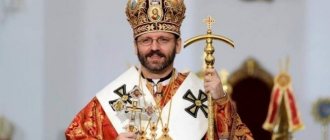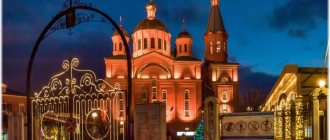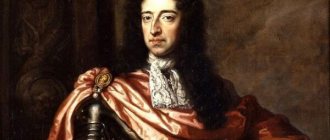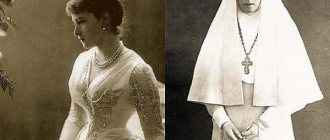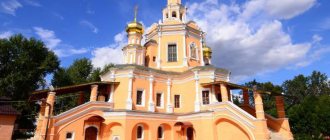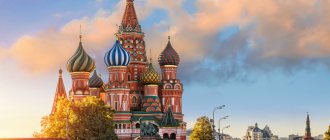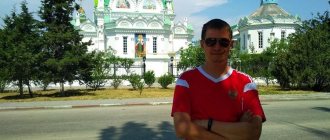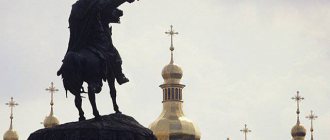German Wiesbaden is famous primarily as a European resort with thermal springs, a place of elite recreation and wellness. The city is also famous for its architectural monuments. One of the most famous places in this corner of Germany, attracting many tourists, is the Church of St. Elisabeth in Wiesbaden and the Orthodox cemetery near its walls. Their history is of considerable interest to travelers visiting Wiesbaden for the first time.
Assumption Cathedral of the Moscow Kremlin
Moscow solemnly welcomed its new Governor-General, Grand Duke Sergius, and his wife on May 5, 1891, at the Nikolaevskaya Railway station (that was the name of the railway from St. Petersburg to Moscow). All the churches on the way to the Kremlin rang their bells, priests came out of the churches and blessed the procession. Now you can repeat the path from the current Leningradsky station (its building has been preserved) to the Iversky Gate, where the governor-general and his wife prayed in the chapel. Then the Grand Dukes went to the Assumption Cathedral, where they were met by Metropolitan Ioannikis - here, however, they will now have to buy a ticket to visit the Kremlin.
Shortly before arriving in Moscow, in April of the same 1891, Grand Duchess Elizabeth accepted Orthodoxy and the sacrament of Confirmation. No longer a Lutheran, in the Assumption Cathedral she venerated the relics of the Moscow saints, the cross and icons.
Many years later, here in the Assumption Cathedral, she will witness the consecration of Patriarch Tikhon.
"1917. November 21. Moscow. Assumption Cathedral. Table of honor from His Holiness Patriarch Tikhon. The Divine Liturgy ends. A deacon emerges from the altar and, on behalf of the patriarch, brings a large prosphora to a woman in monastic attire, modestly lost in the crowd... Having resurrected the images of ancient Russian princesses, the widow of the martyred zealot for Orthodoxy, Grand Duke Sergius Alexandrovich, Grand Duchess Elisaveta Feodorovna and Prince Igor Konstantinovich are present at the service, as if representing the royal family languishing in Tobolsk...
The wooden, simple black staff of St. Peter was handed over to the new patriarch by Metropolitan Vladimir of Kyiv, with a heartfelt word, and His Holiness Tikhon responded, understanding the full weight of the cross placed on him. The procession leaves the cathedral. The Patriarch walks surrounded by people. The Grand Duchess stands with a group of people in the square. The procession is approaching. Suddenly the princess rushes into the crowd, disappears for a few minutes and then returns to her companions, who are afraid for her, beaming with quiet joy. “I was honored to receive the blessing of His Holiness,” says the Grand Duchess, who was destined to be tortured to death by the enemies of Christ the Savior in six months” (N.D. Talberg, “Holy Rus'”).
A letter from Grand Duchess Elizabeth Feodorovna, written by her to Alexandra Olsufieva after the Divine Liturgy celebrated by His Holiness Patriarch Tikhon of Moscow and All Rus', during which she received his blessing, has been preserved. She wrote: “The Holy Kremlin, with noticeable traces of these sad days, was dearer to me than ever before, and I felt to what extent the Orthodox Church is the real Church of the Lord. I felt such deep pity for Russia and for its children, who currently do not know what they are doing...”
How to get to the Russian Church in Wiesbaden
Getting to Wiesbaden to see the Russian church is not difficult. The main thing is to complete the necessary documents, comply with visa formalities and come to Germany.
The closest major city and airport to the German resort is Frankfurt am Main, where the imperial cathedral is located. The flight from St. Petersburg and Moscow takes just over 3 hours. From the airport you need to go to the S-bahn station, from which commuter trains depart. On the website you can choose the most suitable railway travel option for yourself. The distance from Frankfurt to Wiesbaden is approximately 35 km, travel time is about 60 minutes. You can easily purchase tickets from a machine or ticket office.
Since the Temple of Righteous Elizabeth is located on a mountain whose height is about one hundred meters, you can get there from the city by cable car, however, it only operates in the warm season.
You can drive up to the temple by car or walk along the highway - it won’t take much time. There is a free parking lot near the church complex, but you will have to pay to enter the church itself.
Alexandrinsky Palace in Neskuchny Garden
In Moscow, the grand ducal couple settled in the Alexandrinsky Palace in Neskuchny Garden near the Kaluga Outpost. Nowadays this is the old building of the Presidium of the Russian Academy of Sciences (Leninsky Prospekt, building 14).
The estate was created by P.A. Demidov, the son of a Ural breeder and a famous amateur gardener, in the middle of the 18th century. The estates around the estate gradually expanded, and the houses were rebuilt. After Demidov’s death, they were bought first by the Vyazemskys and then by the Orlovs.
In 1832, A.A. Orlova sold the huge estate to the Palace Department. It was named Neskuchny Garden. The main house was Orlova's house, named the Alexandrinsky Palace after the wife of Nicholas I, for whom the estate was built and who fell in love with this residence very much.
Grand Duchess Elizabeth was most attracted to the Alexandrinsky Palace by the house church in honor of the martyr Queen Alexandra, built in 1842 on the third floor of the main house. The walls here were covered with crimson cloth, the white iconostasis was decorated with gilded carved Royal Doors, and among the icons there were images of heavenly patrons of members of the imperial house and saints especially revered by them.
On the initiative of the grand ducal couple, New Year's services began to be held in the house church. Sergei Alexandrovich and Elizaveta Fedorovna thanked God for the blessings of the past year and asked for blessings for the coming year. From them this tradition passed on to other rich noble and merchant houses: especially revered shrines were brought to house churches on the first day of the new or the last day of the old year.
The temple in the Alexandrinsky Palace was closed in 1921. In Soviet times, it housed first the Furniture Museum, then the repository of the Museum of Ethnic Studies, and then the Presidium of the USSR Academy of Sciences (now the Presidium of the Russian Academy of Sciences).
Alexandrinsky (Neskuchny) Palace /https://dedushkin1.livejournal.com/
Schedule of services
Divine services within the walls of the temple are not held daily. According to the calendar of memorable dates of the Orthodox Church, liturgies fall only on special days.
- For example, before Easter (Holy Week) services were held daily.
- In the period after the holiday, liturgies are held on Saturday (evening service at 17:00) and Sunday (at 8:00).
There is a separate schedule for holding services within the walls of the Elizabethan Church for the period of major religious holidays. This information must be clarified in advance for the day you are interested in, since the hours of services in the temple may change.
The Moscow Government and the Holy Martyr Elizabeth
It is difficult to say what its current occupants—members and employees of the Moscow government—remember about the history of the building at 13 Tverskaya Street. Here, during the years of the General Government of Grand Duke Sergei Alexandrovich, a special environment developed around his wife.
In 1785, the mansion on Tverskaya was purchased by the treasury from the widow of Count Chernyshev and became the official residence of the Moscow government. The redevelopment of the building was carried out by Matvey Kazakov, a famous Russian architect. True, the building was badly damaged during the fire of 1812, and acquired a look close to its current one in the 1830s.
During the time of Elizabeth Feodorovna, receptions were held in the beautifully decorated White Hall in honor of Orthodox and public holidays and on the occasion of taking office. On the third floor there were living rooms, a winter garden, a bedroom and the Grand Duke's study. In the 1890s, the nephews of the Grand Duke Maria and Dmitry lived on the second floor under the guardianship of Grand Duchess Elizabeth. On the ground floor there was a dining room, a library, security rooms, a kitchen, apartments for waiters, doormen and bellhops.
Elizaveta Feodorovna would not have been herself if, upon her arrival in Moscow, she had not started arranging a house church in the Governor General’s house on Tverskaya. The temple was refurbished under the leadership of architect Sultanov and dedicated to the memory of Alexander Nevsky and Sergius of Radonezh. The consecration of the renovated temple took place in 1892, when the 500th anniversary of the memory of St. Sergius of Radonezh was celebrated in Moscow. The decoration and utensils were made in the ancient style according to museum samples. The iconostasis was brought from the Church of John the Baptist in Brateevo, where in return the Grand Dukes donated a three-tiered, gilded, expensive iconostasis.
Tverskaya, 13 /https://i.imgur.com/
Alexander-Sergievskaya Church was closed shortly after the revolution, the property was distributed in 1920-1921. In the modern city hall, of course, there is no house church.
Excerpt characterizing the Church of St. Elisabeth (Wiesbaden)
The ignorance of his comrades, the weakness and insignificance of his opponents, the sincerity of the lie and the brilliant and self-confident narrow-mindedness of this man put him at the head of the army. The brilliant composition of the soldiers of the Italian army, the reluctance of his opponents to fight, his childish audacity and self-confidence gain him military glory. Countless so-called accidents accompany him everywhere. The disfavor into which he falls from the rulers of France serves to his advantage. His attempts to change the path destined for him fail: he is not accepted into the service in Russia, and he fails to be assigned to Turkey. During the wars in Italy, he is on the verge of death several times and is saved each time in an unexpected way. Russian troops, the very ones that could destroy his glory, for various diplomatic reasons, do not enter Europe as long as he is there. On his return from Italy, he finds the government in Paris in that process of decay in which the people who fall into this government are inevitably erased and destroyed. And for him there is a way out of this dangerous situation, consisting of a meaningless, causeless expedition to Africa. Again the same so-called accidents accompany him. Impregnable Malta surrenders without a shot; the most careless orders are crowned with success. The enemy fleet, which does not let a single boat through, lets through an entire army. In Africa, a whole series of atrocities are committed against almost unarmed inhabitants. And the people who commit these atrocities, and especially their leader, convince themselves that this is wonderful, that this is glory, that this is similar to Caesar and Alexander the Great, and that this is good. That ideal of glory and greatness, which consists in not only not considering anything bad for oneself, but being proud of every crime, attributing to it an incomprehensible supernatural significance - this ideal, which should guide this person and the people associated with him, is being developed in the open air in Africa. Whatever he does, he succeeds. The plague does not bother him. The cruelty of killing prisoners is not blamed on him. His childishly careless, causeless and ignoble departure from Africa, from his comrades in trouble, is given credit to him, and again the enemy fleet misses him twice. While he, already completely intoxicated by the happy crimes he had committed, ready for his role, comes to Paris without any purpose, the decay of the republican government, which could have destroyed him a year ago, has now reached its extreme, and the presence of him, fresh from a person's parties, now only can elevate him. He doesn't have any plan; he is afraid of everything; but the parties seize on him and demand his participation. He alone, with his ideal of glory and greatness developed in Italy and Egypt, with his madness of self-adoration, with his audacity of crimes, with his sincerity of lies - he alone can justify what is about to happen. He is needed for the place that awaits him, and therefore, almost independently of his will and despite his indecision, despite the lack of a plan, despite all the mistakes he makes, he is drawn into a conspiracy aimed at seizing power, and the conspiracy is crowned with success . He is pushed into the meeting of the rulers. Frightened, he wants to run away, considering himself dead; pretends to faint; says meaningless things that should destroy him. But the rulers of France, previously smart and proud, now, feeling that their role has been played, are even more embarrassed than he is, and say the wrong words that they should have said in order to retain power and destroy him. Chance, millions of coincidences give him power, and all people, as if by agreement, contribute to the establishment of this power. Accidents make the characters of the then rulers of France subservient to him; accidents make the character of Paul I recognizing his power; chance conspires against him, not only not harming him, but asserting his power. An accident sends Enghien into his hands and inadvertently forces him to kill, thereby, stronger than all other means, convincing the crowd that he has the right, since he has the power. What makes it an accident is that he strains all his strength on an expedition to England, which, obviously, would destroy him, and never fulfills this intention, but accidentally attacks Mack with the Austrians, who surrender without a battle. Chance and genius give him victory at Austerlitz, and by chance all people, not only the French, but all of Europe, with the exception of England, which will not take part in the events that are about to take place, all people, despite the previous horror and disgust for his crimes, now they recognize his power, the name he gave himself, and his ideal of greatness and glory, which seems to everyone to be something beautiful and reasonable. As if trying on and preparing for the upcoming movement, the forces of the West several times in the years 1805, 6, 7, 9 rush to the east, growing stronger and stronger. In 1811, the group of people that had formed in France merged into one huge group with the middle peoples. Together with an increasing group of people, the power of justification of the person at the head of the movement further develops. In the ten-year preparatory period preceding the great movement, this man is brought together with all the crowned heads of Europe. The exposed rulers of the world cannot oppose the Napoleonic ideal of glory and greatness, which has no meaning, with any reasonable ideal. One in front of the other, they strive to show him their insignificance. The King of Prussia sends his wife to curry favor with the great man; the Emperor of Austria considers it a mercy that this man accepts the daughter of the Caesars into his bed; the pope, guardian of the sacred things of the people, serves with his religion the exaltation of a great man. It is not so much that Napoleon himself prepares himself to fulfill his role, but rather that everything around him prepares him to take upon himself the full responsibility of what is happening and is about to happen. There is no act, no crime or petty deception that he has committed that is not immediately reflected in the mouths of those around him in the form of a great deed. The best holiday that the Germans can come up with for him is the celebration of Jena and Auerstätt. Not only is he great, but his ancestors, his brothers, his stepsons, his sons-in-law are great. Everything is done in order to deprive him of the last power of reason and prepare him for his terrible role. And when he is ready, so are the forces. The invasion is heading east, reaching its final goal - Moscow. The capital is taken; The Russian army is more destroyed than enemy troops were ever destroyed in previous wars from Austerlitz to Wagram. But suddenly, instead of those accidents and genius that had so consistently led him so far in an unbroken series of successes towards his intended goal, there appears a countless number of reverse accidents, from a runny nose in Borodino to frost and the spark that lit Moscow; and instead of genius there are stupidity and meanness, which have no examples. The invasion runs, comes back, runs again, and all the coincidences are now no longer for, but against it. There is a counter-movement from east to west with remarkable similarity to the previous movement from west to east. The same attempts at movement from east to west in 1805 - 1807 - 1809 precede the great movement; the same clutch and group of huge sizes; the same pestering of the middle peoples to the movement; the same hesitation in the middle of the path and the same speed as you approach the goal. Paris - the ultimate goal has been achieved. Napoleonic government and troops are destroyed. Napoleon himself no longer makes sense; all his actions are obviously pathetic and disgusting; but again an inexplicable accident occurs: the allies hate Napoleon, in whom they see the cause of their disasters; deprived of strength and power, convicted of villainy and deceit, he would have to appear to them as he appeared to them ten years ago and a year after - an outlaw robber. But by some strange chance no one sees this. His role is not over yet. A man who ten years ago and a year after was considered an outlaw robber is sent on a two-day journey from France to an island given to him in possession with guards and millions who pay him for something. The movement of peoples begins to settle into its shores. The waves of the great movement have subsided, and circles are formed on the calm sea, in which diplomats rush, imagining that they are the ones causing the lull in the movement. But the calm sea suddenly rises. It seems to diplomats that they, their disagreements, are the reason for this new onslaught of forces; they expect war between their sovereigns; The situation seems insoluble to them. But the wave, the rise of which they feel, is not rushing from where they expect it. The same wave is rising, from the same starting point of movement - Paris. The last surge of movement from the west is taking place; a splash that should resolve the seemingly intractable diplomatic difficulties and put an end to the militant movement of this period. The man who devastated France, alone, without a conspiracy, without soldiers, comes to France. Every watchman can take it; but, by a strange coincidence, not only does no one take it, but everyone greets with delight the man whom they cursed the day before and will curse in a month.
Bolshoi Theatre, Moscow Conservatory, Theater School
Grand Duchess Elizaveta Feodorovna was a trustee of the Moscow Philharmonic Society and the Music and Drama School that was attached to it, as well as the directorate of the Imperial Theaters, which was closely connected with the society. Gradually, the Philharmonic Society became the center of cultural life in Moscow.
Once, even before the founding of the monastery, Elizaveta Feodorovna, as the wife of the Governor-General, instead of the usual reception for Moscow society, gave a performance in her house with the participation of amateurs from high society. The high-society performance was very successful and turned out to be very significant for the future theater of Vladimir Nemirovich-Danchenko.
It was obvious to Nemirovich-Danchenko that a theater school without a theater, where students would receive their first stage practice, was useless. Since the development of both the theater and the school was hampered due to lack of money, Nemirovich-Danchenko decided to leave the school. But Elizaveta Fedorovna said that she could not imagine the school without him. This was enough to speed up the opening of the theater and the development of the school using funds allocated by merchant patrons.
In 1918, the school was reorganized into the Institute of Musical Drama, on the basis of which the State Institute of Theater Arts (GITIS) later emerged.
The Historical Museum and the Museum of Fine Arts were also created under the care of the grand ducal couple.
According to Professor I.K. Kuchmaeva, the author of several books about the life, exploits and charity of the Grand Duchess, before the death of her husband, Elizaveta Feodorovna often visited both the Bolshoi Theater and the Moscow Conservatory, where she listened to both European and Russian works.
Moscow Imperial Bolshoi Theater in 1905 /https://ru.wikipedia.org/
Bibliography
- English Kirche auf dem Neroberg in Wiesbaden — Geschichtlicher Überblick und Beschreibung der Kirche, Eigenverlag des Kirchenvorstandes
- Wiesbaden - Russische Kirche, Kloster des Hl. Hiob von Počaev in München. — 3. Auflage. - Berlin-München, 2000. - ISBN 3926165952.
- Baedeker Wiesbaden Rheingau, Karl Baedeker GmbH, Ostfildern-Kemnat, 2001, ISBN 3879540764
- Das verkannte Jahrhundert. Der Historismus am Beispiel Wiesbaden, Gottfried Kiesow, Deutsche Stiftung Denkmalschutz, 2005, ISBN 3936942536
- Antonov V.V., Kobak A.V.
Russian churches and monasteries in Europe. - St. Petersburg: “Faces of Russia”, 2005. - P. 73-76. — 3000 copies. — ISBN 5-87417-208-4. - Dr.
Dirk Becker. Vivat Wiesbaden. Spaziergänge zwischen Tradition und Moderne. Ein Stadtführer für Wiesbaden und Umgebung. - Wiesbaden: Universum Verlag, 2006. - ISBN 389869141-1.
| Germany Switzerland | Kissingen · Homburg |
| Austria-Hungary | Vein · Iröm |
| Bulgaria | Bakajik · Sofia |
| Rest of Europe | Athens · Belgrade |
| Palestine | Jerusalem · Gethsemane |
| USA and Canada | Manhattan · Brooklyn |
| Other countries | Buenos Aires · Beijing |
Uspensky Lane: Elizavetinsky Charitable Society
In 1892, Grand Duchess Elizabeth organized the Elizabethan Charitable Society to “look after the legitimate babies of the poorest mothers, who had hitherto been placed, although without any right, in the Moscow orphanage under the guise of being illegal.” Elizabethan committees were formed in all Moscow parishes and in all district cities of the Moscow province. Over 25 years of operation, the Society has taken part in the fate of more than nine thousand children and paid widowed mothers 13 thousand benefits totaling 120 thousand rubles.
The house where the charitable society lived has been preserved. In 1817, the collegiate assessor M.P. Zvereva built herself a mansion on Uspensky Lane, which in 1899 was purchased by the Elizabethan Charitable Society for an orphanage.
The wooden mansion was covered with bricks and decorated with tiles according to the design of Sergei Voskresensky. Teachers lived in the house, and a school building and bedrooms appeared in the courtyard.
/https://s15.radikal.ru/
Now sculptors Friedrich and Vahe Soghoyan live in this house, there is also a workshop here, and many sculptures are stored right in the open air. These are mainly small copies of monuments installed in various Russian and Armenian cities.
Photos
Exterior view of the Elizabethan Temple:
Classes at the temple for adult parishioners:
Interior of the temple:
The Elizabethan Temple of the Queen is one of the centers of the spiritual and educational life of the city. Thanks to the tireless work of the ministers and rectors of the church, classes are held within its walls that teach about the Law of God, as well as other topical issues of church life.
Disappeared Moscow: Chudov Monastery
On the day of their arrival in Moscow from the Assumption Cathedral, the Grand Duke and Grand Duchess went to the Miracle Monastery in the Kremlin (it was completely destroyed during the Soviet years). Here - in the Kremlin and the Chudov Monastery - the path of Sergei Alexandrovich ended: in February 1905, the terrorist Socialist Revolutionary Ivan Kalyaev threw a bomb right in the Kremlin at the Grand Duke who was getting into the carriage. The Grand Duchess at that time was at the Red Cross warehouse in the Grand Kremlin Palace. Hearing the explosion, she rushed to the square and collected the remains of her husband from the bloody snow, and then walked on foot to fetch a stretcher to the Chudov Monastery.
Miracles Monastery during the coronation of Nicholas II /https://ru.wikipedia.org/
The Grand Duchess often went here to pray while the coffin stood here and for another forty days after, to the shrine of St. Alexis of Moscow. Here the Grand Duke was buried in a specially constructed crypt. This crypt was discovered in 1985 during renovation work on Ivanovo Square in the Kremlin. Then all metal objects were removed from the burial, and a parking lot was built over the grave. The remains of the Grand Duke were transferred to the Novospassky Monastery, where they remain now, a little more than ten years later.
The coachman, who faithfully served the Grand Duke for 25 years, also died from wounds after the terrorist attack. Together with his widow, the Grand Duchess walked along the coffin to the Paveletsky station. In the Stupino district, where he was buried, she erected a monument at his grave (destroyed during the years of Soviet power).
At the site of the murder of Prince Sergei Alexandrovich on Senate Square in the Kremlin, a six-meter memorial cross was erected with the inscription “Forgive them, Lord, they don’t know what they are doing” - it was destroyed on May 1, 1918, and Lenin personally participated in the destruction.
Notes
- [english.wiesbaden.de/loader.php?menue=/die_stadt/stadtinformation/menue.php&content=/die_stadt/stadtinformation/historismus/orte/russischekirche.php 100 Examples of Historicism: Churches & Houses of Prayer]
- [english.wiesbaden.de/loader.php?menue=/die_stadt/stadtinformation/menue.php&content=/die_stadt/stadtinformation/historismus/orte/russischekirche.php 100 Examples of Historicism: Churches & Houses of Prayer].
- During the Second World War, the temple was closed, and winter services were moved to the crypt of the temple-tomb.
